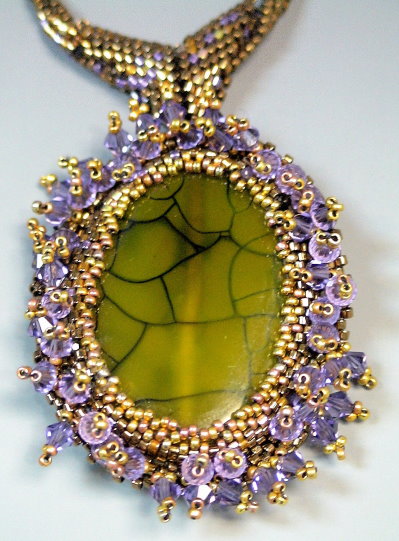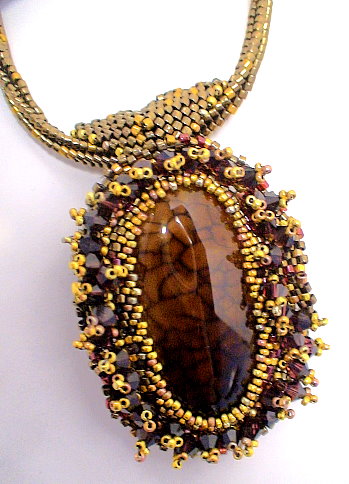| Palette
1: Fire Opal

Olive
Fire Opal

Brown
Fire Opal
In the BezelWorks Pendant project...
What You Will Learn:
- Discussion of "Jewelry as Art" vs.
"Jewelry as Craft" vs. "Jewelry as Design"
- Review of "Fringe" Theory, the Design Process, and
Playing with a Variety of Applications
- Review of "Edge" or Boundary Theory, the Design Process,
and Playing with a Variety of Applications
- Review of "Strap" Theory, the Design Process, and
Playing with a Variety of Applications
- Review of "Bail" Theory, the Design Process, and Playing
with a Variety of Applications
- Review of "Canvas" Theory, the Design Process, and
Playing with a Variety of Applications
- Review of "Surface Embellishment" Theory, the Design
Process, and Playing with a Variety of Applications
- Within the Framework of the Ideas Discussed, Creating a Pendant
Center Piece, using tubular and circular peyote, a peyote
bail, and a strap using spiral tubular Ndebele
|
BEZELWORKS
PENDANT
About the Kit...
If
jewelry is "art", is the entire piece the art, or only
the center piece, or central focal part the art? Classical art
theory holds that the fringe, strap, edging, bail, and other similar
parts should supplement or support the center piece or focal center.
This theory holds that these jewelry structures are not art.
They should function like a frame to a painting, or a pedestal
to a sculpture.
It
is, however, often difficult to separate the jewelry's anatomy
like this, with one part important and the other parts supplemental.
This BezelWorks Pendant project is, in part, designed to foster
ideas, discussion and debate about the roles of fringe, edge,
strap, bail and surface embellishment. Each of these is critical
to the finished piece.
For
each of these anatomical parts or extensions to our piece of jewelry,
we need to understand it in terms of:
- What it is, its purpose, its role
- What value it has to the piece
- How it makes the piece more or less satisfying
- What principles should regulate it
- Whether it is part of the art or not
Center
Piece
The
central project: A BezelWorks Pendant, with open-back peyote bezel.
How do we go about designing an aesthetically pleasing, well-functioning,
center piece? What functions does the center piece serve? How
do we make choices about size, design, proportions, placement?
Edge,
Frame, Boundary, Line
The
Center Piece has a bezel, creating an interior edge encircling
our stone. In addition, the we weave a frame around the entire
Center Piece, creating an additional key edging component.
Edging
is used to give a finished look to the piece. It might be used
to hide threads. It might be used to hide any irregularities in
how beads line up or are juxtaposed. An edging strategy is especially
critical, however, for creating, preserving, blurring, or otherwise
affecting the boundary line, line curvature, and/or silhouette
of the center piece or the piece of jewelry as a whole.
What
role does the “border” of a piece play? Does it mark
a beginning/ending? How does it help the viewer appreciate the
emotional content of the piece?
What
kinds of positioning issues are associated with the placement
on an edge, boundary, border or line?
Fringe
and Surface Embellishment
We
weave Fringe Embellishment off our Frame. So what exactly is fringe,
and what can fringe be? How does the fringe make the piece more
or less satisfying? There are numerous possibilities.
In good jewelry design, the Fringe and/or other Surface Embellishment
would play either a supporting, or a co-equal role, with the center
piece. It would not overwhelm or be overdone. It would seem as
if the fringe were organic part of the piece. It would not seem
like an afterthought. If it's primary purpose is to hide flaws,
no one should notice. Too often, designers overdo the fringe.
Straps
The
Center Piece hangs from a thin, twisted Ndebele tube Strap. What
are the visual and functional purposes of the strap? What should
the strap look like? How should the strap be connected to the
piece? Where should the strap be connected to the piece? To what
extent is or should the strap be as an integral part of the piece
of jewelry as art? How does the strap define a silhouette? How
does the strap make the piece more or less satisfying?
Bails
In
our piece, a Bail is connected directly to the Center Piece, and
the strap moves through it. A bail changes the visual and artistic
relationship between the strap and the center piece. How might
this be helpful, and how not? The bail poses similar design challenges
as the strap -- size, proportion, placement and attachment. However,
it has to succeed at one additional task -- it has to control
the visual, aethestic and functional transitioning between the
center piece and the strap.
The
Canvas
We
have two things which serve as "Canvas". The most obvious
is the stringing material. In this project, we use beading thread
for some parts, and a cable thread for others. The other part
which serves as "Canvas" are the woven beads which for
the basis of our Frame, and off of which we add Fringe.
The
"canvas" in a piece of jewelry may be the stringing
material, and how it is worked off of. It might be another piece
of beadwork, such as a beaded base, off of which some center piece
is developed. It might be a core line of beads. It might be a
piece of fabric or other material. How does the canvas influence
the interpretation of jewelry as art? How should the canvas interact
with the main piece and its components? To what extent should
it become part of the artwork itself; and to what extent, not?
Classic Art theory suggests that the canvas should NOT be a part
of the artwork at all.
|